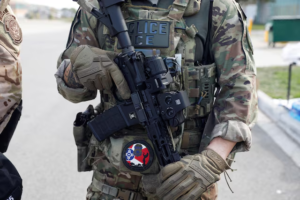Hamas long has viewed former President Donald Trump as a villainous figure — calling him a “racist,” “a recipe for chaos,” and “a man with an absurd vision for Gaza.” But in a dramatic turnabout, a series of back-channel negotiations and a key telephone call last month appear to have calmed the militant organization sufficiently that it now believes Trump might be able to stop Israel and force a new ceasefire accord.
As reported by several Palestinian officials with knowledge of the talks, Hamas’ signing of the Trump-brokered ceasefire announced on Wednesday and becoming effective Friday is a significant bet — one that has the potential to turn the tide of the Gaza conflict that has lasted since October 7, 2023.
A Turning Point Phone Call and Shift in Attitude
The sudden change in Hamas’ stance allegedly began in September in a phone call between Trump and the Prime Minister of Qatar, when Trump unexpectedly passed the phone to Israeli Prime Minister Benjamin Netanyahu to apologize for an Israeli air raid on a Doha residential tower. The raid had struck senior Hamas political figures, including chief negotiator Khalil al-Hayya, but failed to kill them.
Trump’s reaction to the incident — publicly acknowledging the mistake and assuring the leadership in Qatar — gave Hamas the impression that he was able to stand up to Netanyahu and rein in Israel’s military hegemony, sources said. The gesture resonated deeply, especially since Qatar has been a major political and financial backer of Hamas.

“Trump never shied away from criticizing Israel if he felt that they overshot a line,” explained a high-ranking Palestinian government official. “It created the impression that he was indeed able to enforce a lasting ceasefire.”
A Risky Ceasefire Without Full Israeli Withdrawal
In the new deal, Hamas agreed to release all other hostages without gaining a solemn assurance of a complete Israeli withdrawal from Gaza — a significant concession. Two senior Hamas officials admitted that it was a risk founded on the belief that Trump’s personal interest in the deal would make him reluctant to let it fall apart.
However, there are questions. Hamas fears Israel will continue attacking once the hostages are released, as happened after a January 2024 ceasefire, facilitated by Trump’s negotiators but which collapsed in weeks.
Gathered in Egypt’s Red Sea resort town of Sharm el-Sheikh for backroom diplomacy, Hamas delegates were reassured by the presence of blue-chip brokers — including Trump son-in-law Jared Kushner, special envoy Steve Witkoff, and regional officials from Qatar, Egypt, and Turkey — who worked tirelessly to close the deal.
Trump was said to have called the conference center three times during the last round of negotiations, showing his personal interest. “His impatience hung in the room,” reported one of the Hamas officials.
Trump’s 20-Point Gaza Plan: Ambitious but Uncertain
While the ceasefire itself can be a watershed moment, questions exist regarding Trump’s 20-point Gaza peace plan’s next steps. The plan envisions a staged Israeli withdrawal, reconstruction assistance led by Gulf states, and an path to a demilitarized Palestinian state.
Hamas’s fresh optimism about Trump stems in part from his hard-edged handling of past crises — like the June 2024 Israel-Iran ceasefire, during which Trump instructed both parties to hold their fire, even telling Israeli warplanes to “turn around” en route during a planned raid on Tehran.
“Though he can be theatrics, he does what he says he will,” said a Palestinian official. “That led Hamas to believe he may actually get peace done.”.
Trump’s public promise to put an end to additional Israeli attacks on Qatar also reinvigorated Arab countries’ belief in his credibility. Political theatrics and unpredictability, as per experts, has paradoxically placed Trump at the central point in the sensitive Middle East equilibrium.
Tense Negotiations and Diplomatic Pressure
Talks over the ceasefire were strained. Up to Tuesday, talks had reached a standstill over when Israeli troops would pull out and under what terms hostages would be freed. Qatari, Egyptian, and Turkish mediators were unable to break the impasse until Qatar’s Prime Minister Sheikh Mohammed bin Abdulrahman Al Thani traveled personally to Sharm el-Sheikh.
His intervention, however, coupled with Kushner and Witkoff’s visit the next day, brought momentum back. Turkey’s intelligence chief, Ibrahim Kalin, also did his part, capitalizing on Ankara’s close ties to Hamas and the fact that Turkish President Recep Tayyip Erdoğan had just met Trump. Erdoğan is reportedly said to have agreed to help persuade Hamas to take the offer on Trump’s direct request.
Hamas, for two years, had refused to release the hostages unless there was a complete Israeli withdrawal and the termination of hostilities, while Israel had requested the total disarmament of Hamas and the release of all the captives as a precondition for ending its attack.
The eleventh-hour deal satisfies both sides reasonably well — Israel will be able to retain authority over the approximately half of Gaza it currently occupies, and Hamas remains a political and military entity, although the disarmament question has been pushed to the next round of negotiations.
From Leverage to Liability
One of the most dramatic turning points in the talks, U.S. and Palestinian officials reported, was when Hamas realized that holding hostages was no longer an asset but a liability.
“Leadership realized that the longer they held civilians as hostages, the more evaporating was the international support for the Palestinian cause,” declared a top American official. With no hostages, Hamas hopes Israel will be deprived of its best reason for resuming attacks.
Still, no formal written guarantees exist to ensure the ceasefire’s next phases are implemented. Instead, Hamas accepted verbal assurances from the U.S. and regional mediators — Egypt, Qatar, and Turkey — that Trump will personally oversee enforcement and prevent Israel from reigniting the conflict.
“As far as we’re concerned, this agreement ends the war,” a Hamas official told Reuters.
The Gamble That Could Backfire
Despite the cautious optimism, Hamas commanders are cognizant of the fact that their decision may be disastrous. During the January cease-fire, Trump abruptly demanded all hostages to be freed at once — a move that made the deal collapse and fighting resume. That breakdown had over 16,000 Palestinian civilians killed, according to Gaza health officials, and an escalating humanitarian emergency of famine and sieges.
Regional diplomats warn that Israel is likely to strike opportunistically still, especially if rocket attacks or border clashes resume. But most believe the current momentum — backed by Egypt, Qatar, Turkey, and the U.S. — offers firmer backing for this ceasefire.
“This time, it feels different,” said one Hamas representative. “Both sides seem serious, and international pressure is huge.”
Trump is expected to fly to the Middle East later this week on a “victory lap” after being invited by Egyptian President Abdel Fattah al-Sisi. The trip can assist in cementing the fragile ceasefire and in proving Trump’s resurgence to the global diplomatic scene, experts say.
It’s a shrewd play by Cairo,” said one source close to the talks. “If Trump stays engaged personally, then the deal has a chance to hold up.”
Summary
The Trump-brokered Gaza ceasefire is one of the most improbable diplomatic breakthroughs of recent times — a compromise created through personal diplomacy, regional coercion, and political risk-taking on all sides.
For Hamas, it’s a wager that Trump’s ambition for a legacy-bestowing peace will be greater than his long-standing hostility. For Israel, it’s a challenge of restraint. And for the broader Middle East, it’s a cautious step toward peace — one which might serve to anchor Gaza or dissolve into another disastrous cycle of war.




